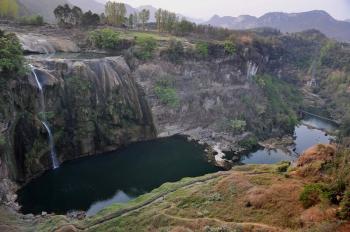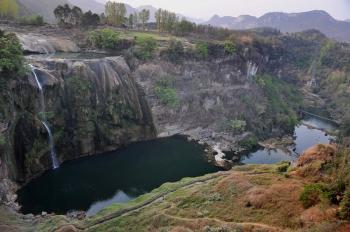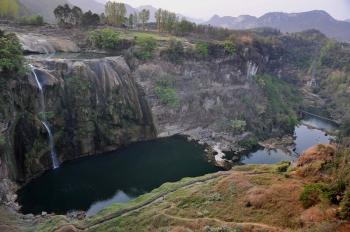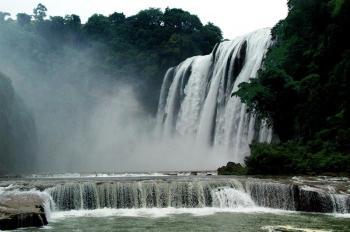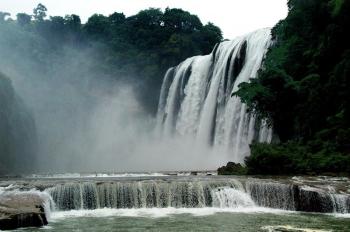The rivers and lakes which inspired the Chinese to refer to Guilin as “the most beautiful under Heaven” are disappearing as the severe drought in southwest China continues unabated.
Huangguoshu Waterfall at Standstill
Tourism in southwest China has likewise been threatened by the drought. The Huangguoshu Waterfall in Guizhou Province is now only a quarter of its normal size due to the decreased water flow upstream.
In the past, the great waterfall sent forth billows of mist and vapor, and its roaring waters could be heard more than a mile away. The falls are now so silent that one has to get very close to notice its presence.
On March 26, the waterfall almost dried up. The once-surging waterfall presented a rare picture of tranquility that morning.
Reports indicate that nine of the 10 water reservoirs in the city of Anshun, where the falls are located, have dried up, and that drinking water supplies in Yunnan Province have been adversely affected.
Li River Dry
Guilin in Guangxi Province is famous for its shapely limestone mountains and crystal-clear waters. A popular Chinese saying describes Guilin’s scenery as the best in the world, and it is one of the best-known tourist destinations in China.
According to a report published in the Changjiang Daily on March 22, Guilin has been badly hit by the drought. The Li River, often considered the epitome of beautiful Guilin scenery, has turned into a thin stream, and its water levels continue to decline. A lot of the riverbed is bare, and in other places the water level is so low that underwater stones are clearly visible.
An elderly Longchuangpin jetty boatman said he had never seen the waters so shallow in the 46 years of his sailing career.
Drinking water supplies affected
Reports say that the drought has left over eight million residents in Yunnan Province with insufficient drinking water. The near-by mountain areas have been hit the hardest.
An Internet post with pictures, said to be taken in Sapiwu, a village in Nanhua County of Yunnan, circulated widely on the Web. The pictures show children forced to drink muddy water from nearly dried-up rivers and wells.
Maotai Liquor Production Stopped
The production of China’s national liquor, Maotai, has also been impacted by the drought. Among the hundreds of Maotai workshops and the small distilleries in the town of Maotai, almost half have had to suspend operations, while the rest are relying on high-priced water to keep production going.
With the water in the Chishui River drying up, and no guarantee of a supply of tap water, it is hard to tell when the closed-down distilleries will reopen. The planting of sorghum, the major grain for making Maotai, has also been affected, and liquor prices are likely to soar in the future.
Yu Jihua, director of the town’s Agricultural Office, estimated that more than 200 distilleries in two famous Maotai-producing villages have been affected by water shortages, and a recent dispute over water supplies with Sichuan Province was reported by the Chongqing Evening News on March 25.
In Cangtouba, a village over 12.5 miles from Maotai, almost every household has wine cellars. This time of the year is usually the busiest for liquor production, but many workshops have had to close. Xiong Shunbang, a local resident, has five cellars with a monthly production of over 5.5 tons of liquor, yet this year his business has been closed for three months, according to the same report by the Chongqing Evening News.
The Web site of the Yangzhou Evening News reported on March 26 that some distilleries shell out extra money on water to continue operations. “In the past it was easy to get water from the Chishui River to make liquor,” said Zheng Guocai, manager of a small distillery in Maotai. “Now I have to buy high-priced water every three to four days. One truck can only carry 20 tons of water, and the delivery costs 500 yuan (US$73) per truck.”
Read the original Chinese article.
